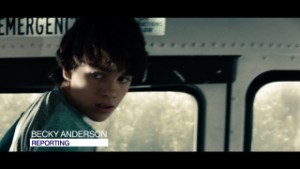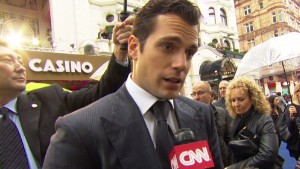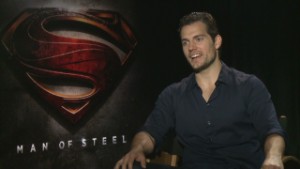- "Man of Steel" director Zack Snyder says his Superman is intended to be spiritual
- Snyder says there are Christ-like parallels to the superhero
- He says the film is intended to let the audience see the world through Superman's eyes
(CNN) -- How is director Zack Snyder's take on Superman in "Man of Steel" any different from earlier screen versions? After all, Christopher Reeve created an iconic figure in Richard Donner's 1978 classic (and sequels), while Brandon Routh made an attempt in Bryan Singer's "Superman Returns" in 2006. But as composer Hans Zimmer previously hinted to CNN, this Kal-El is a little more spiritual.
"When we started to examine the Superman mythology, in the most classic sense, I really wanted to press upon the film the 'why' of him, which has been 75 years in the making," Snyder told CNN. "The Christ-like parallels, I didn't make that stuff up. We weren't like, 'Hey, let's add this!' That stuff is there, in the mythology. That is the tried-and-true Superman metaphor. So rather than be snarky and say that doesn't exist, we thought it would be fun to allow that mythology to be woven through."
At 75, is Superman still our hero?
Snyder starts with the arrival of an infant Kal-El via a miracle birth on his home planet, Krypton. All the other Krypto-babes are genetically engineered, groomed by a process of selection that predetermines their function in society, but Kal-El was made the old-fashioned way, with love.
Jor-El, Superman's father (Russell Crowe), helps deliver the child, to emphasize how much the father is involved with the process. But since Krypton is dying and cannot be saved, Jor-El sends this miracle baby to Earth, to save us. "He will be like a god to them," he says at one point.
 Crowe: 'Man of Steel' best Superman movie
Crowe: 'Man of Steel' best Superman movie
 'Man of Steel' lands in London
'Man of Steel' lands in London
 Meet the new Superman
Meet the new Superman
Named Clark, he's raised by humble Midwestern folks Martha and Jonathan (originally Mary and Joseph in the comics). We tend to think of the adult Clark Kent toiling away at The Daily Planet, but this Clark (Henry Cavill) is a manual laborer -- not quite a carpenter, but the parallel is there.
"This character has a balance between the modern world that we live in, and the archetype that exists in this ancient, other way," Snyder said. "I wanted to make it real."
Unlike the Superman of previous films, this take means the world isn't aware of his existence for a long time. Not until he's 33 is Kal-El called upon to sacrifice himself for a world that may not even believe he exists, and he finally reveals who and what he is. Cavill is not strutting around in a Superman suit for a large part of the film -- he's even got a beard for a while.
This Clark is more humble, more troubled, more conflicted. As a child, he was even bullied -- and refused to fight back, knowing he would hurt his schoolmates more than they deserved. Of course, it makes him seem weaker than he is and gives him a new emotional template.
"He's reinvented anew," Snyder said. "He's more down to earth, even though he's also this larger-than-life, impossible figure. Our thesis was, look through Superman's eyes. Feel what he feels. That's where we started, and once you do that, you're in different territory, and that organically changed stuff along the way for us. This exists beyond what I'm going to do here, and what someone else would do beyond me. I really wanted there to be an echo of that throughout the film, and enshrine it for all time."
Krypton is also reinvented, with an opening sequence that lets the audience see more of that world than ever before, including giving General Zod (played by Michael Shannon) and his followers much more of a reason to track Kal-El down on Earth.
"I was really excited to do that stuff," Snyder said. "I love sci-fi, and I wanted this big story to be at the front of the movie and have it be engrossing enough so that when the pod finally crashes on Earth, you go, 'Oh, that's right! We're in a Superman movie. I forgot for a second.' You think during the Krypton sequence, 'Oh! This is the movie, I guess.' "
Snyder says he felt beholden to the Superman mythology that exists in the comics, but he also felt free to mix up characters and situations (i.e., turning Jimmy Olsen into Jenny Olsen). "I felt it was natural to do that," he said. "We wanted to take this concept of Jimmy Olsen, and not have everything be as exactly aligned as it is. Not everyone has to assume the exact roles that we expect them to.
"The preconceived idea you have about who these characters are -- you can play with it a bit and let the world open up because of that. And then you don't know what's going to happen, because you don't know what your characters are capable of."
Talk of a sequel and a "Justice League" film is already under way, and Snyder prepared for this film to fit within a larger canvas. Lex Luthor does not appear, but a LexCorp logo can be found on many a building or construction site that gets destroyed during a showdown with General Zod. Could this be foreshadowing? "Absolutely," Snyder said.
Will Luthor be upset that his buildings were damaged, or somehow benefit from the business he'll get from reconstructing Metropolis, setting up a future altercation?
"I like that," Snyder said, laughing. "I'm writing that stuff down to use it later."
And then there's the Wayne Enterprises logo on a satellite, which signals that Gotham and Metropolis can co-exist. "That was also to thank (producer) Chris (Nolan), for being a great partner and a great friend, and just acknowledge that inside the movie, and like the LexCorp thing, say, 'Maybe this world is bigger than you think.' "